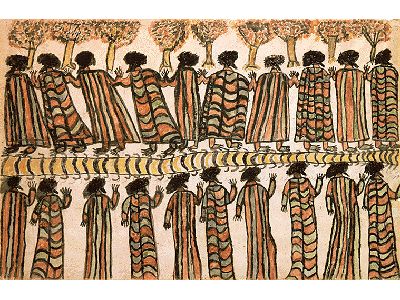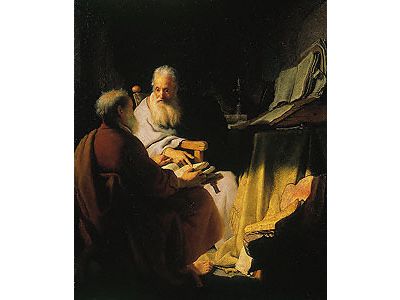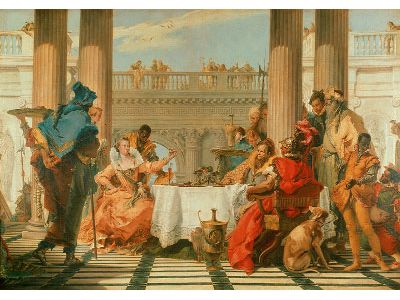MEASUREMENTS: 57.0 x 88.8cm PROVENANCE: Purchased 1962.
National Gallery of Victoria
While Australia's oldest public art gallery The National Gallery of Victoria undergoes a program of redevelopment, a temporary gallery is located at 285-321 Russell Street. The magnificently restored 19th century galleries at Russell Street house over 700 key works from the NGV's permanent collection. The National Gallery of Victoria on Russell marks the Gallery's return to its original home, which it occupied from 1861 until the move to the Roy Ground's designed building in St Kilda Road in 1968.
The National Gallery of Victoria International Art will open in 2002 at the St Kilda Road site and will offer improved display spaces, conservation and collection storage systems for the NGV's collection of International Art.
The redevelopment program will result in the opening, in early 2001, of the National Gallery of Victoria Australian Art at Federation Square, which will include display space for the contemporary art and major temporary exhibitions drawing on the NGV's collection of Australian Art.
Subject:
- Art Gallery
- Art
- Photographs
- Contemporary Art
- Craft
- Decorative Arts
- Design
- Drawings and Prints
- Furniture
- Glass
- Illuminated Manuscripts
- Jewellery
- Metalwork
- Painting
- Paper
- Pottery and Ceramics
- Sculptures
- Textiles, Spinning and Weaving
- Woodwork
- Aboriginal Art
- Aboriginal Artefacts
- Asian Cultures
- Pacific Cultures
- Torres Strait Cultures
- Dolls
- Literature
- Popular Culture
Items
Pencil, wash, charcoal solution
Figures in Possum Skin Cloaks

Oil on canvas
Collins St., 5 p.m.

MEASUREMENTS: 114.8 x 162.8cm PROVENANCE: purchased 1956
Oil on wood
Two Old Men Disputing (Peter and Paul)

MEASUREMENTS: 72.4 x 59.7cm. PROVENANCE: Felton Bequest, 1936
Oil on wood
Triptych with the Miracles of Christ

Medieval workshop practice often meant that several artists were responsible for larger projects. A striking example of the outcome of this is the Flemish Triptych with the Miracles of Christ which has been attributed to at least four different hands believed to be either members of Rogier van der Weyden’s workshop or a continuation of this in Brussels. The Triptych was purchased from the widow of the nineteenth-century British art patron and collector, Lord Leyland, for the Felton Bequest in 1922. Thematically and iconographically the work holds great interest. Historians have identified several members of the House of Burgundy including Philip the Good amongst those witnessing the Miracles of Christ, although these portraits are not now thought to be connected with the original donation of the Triptych. MEASUREMENTS: 172.4 x 184cm. PROVENANCE: Felton Bequest, 1922
Oil on Canvas
The Banquet of Cleopatra

In 1932 the oil painting The Banquet of Cleopatra painted in 1743-45, was offered for sale in England by the bankrupt Russian government anxious for foreign currency. The provenance of the work from Tiepolo’s studio to the collection of Catherine the Great of Russia has been carefully charted by Dr Ursula Hoff and the painting was acquired on the advice of Randall Davies for the Felton Bequest in 1932 a spectacular addition to the largely British-based collection then being formed in Melbourne.
Tiepolo made a number of drawings and oil sketches and at least one known oil painting, the Melbourne Banquet of Cleopatra, on this theme, which he derived from Pliny’s Naturalis Historia, Book IX, Chapter LVII.
Pliny relates that the two largest pearls in history were owned by Cleopatra, Queen of Egypt. She was made a wager that she would spend 10 000 000 sesterces (a fortune) on a single banquet. The painting depicts the wager at its high point of tension when, seated at the table between Antony and adjudicator Lucius Plancus, she has removed one of the pearls from her ear and is about to drop it into a goblet of vinegar, which will dissolve it. The story is told disapprovingly by Pliny, as an instance of unacceptable luxury. But Tiepolo has painted it as a magnificent gesture, splendidly set. The colouring is high and delicate and Tiepolo’s mastery of illusionistic space, his delight in exotic detail with the dwarf, the Nubian pages, the animals as accessories Antony’s greyhound and Cleopatra’s miniature with the picaresque spectators, all revel in the spectacle. MEASUREMENTS: 250.3 x 357.0cm. PROVENANCE: Felton Bequest, 1933
